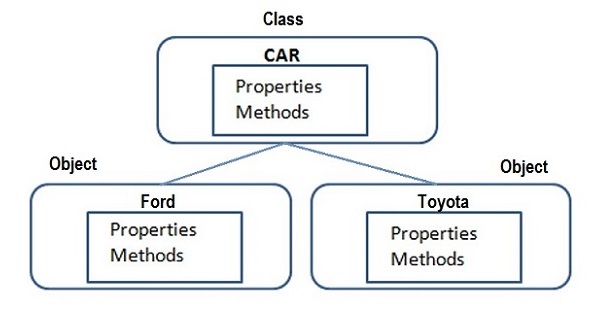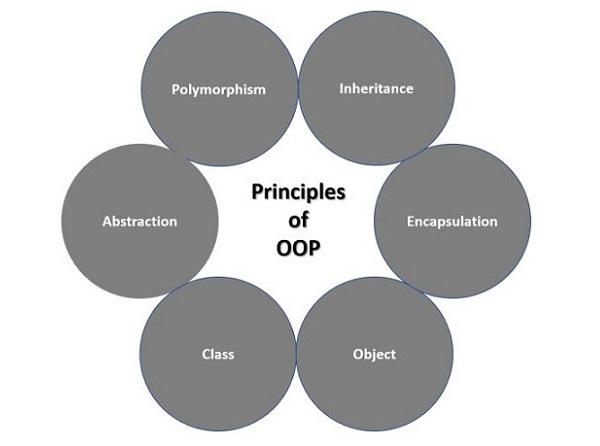OOP 是面向对象的编程范式(Object-oriented programming)的缩写。它被定义为使用对象概念的编程模型,该概念是指具有状态和行为的真实世界实体。本章可帮助您成为在 Python 语言中使用面向对象编程支持的专家。
Python 是一种支持面向对象编程的编程语言。这使得创建和使用类和对象变得简单。如果您之前没有任何面向对象编程的经验,那么您来对地方了。让我们首先讨论一个简短的面向对象编程 (OOP) 简介来帮助您。
面向程序的方法
50 年代和 60 年代开发的早期编程语言被认为是过程(或面向过程)的语言。
计算机程序描述了通过按逻辑顺序编写一系列指令来执行特定任务的过程。更复杂程序的 Logic 被分解为更小但独立且可重用的语句块,称为函数。
每个函数的编写方式都使其可以与程序中的其他函数交互。属于函数的数据可以很容易地以参数的形式与其他函数共享,并且被调用的函数可以将其结果返回给调用函数。
与程序方法相关的突出问题如下 -
- 其自上而下的方法使程序难以维护。
- 它使用了大量的全局数据项,这是不希望的。全局数据项过多会增加内存开销。
- 它更重视过程,不认为数据同等重要性,而是认为它是理所当然的,因此它在程序中自由移动。
- 跨函数的数据移动不受限制。在实际场景中,函数与预期要处理的数据之间存在明确的关联。
Python - OOP 概念
在现实世界中,我们处理和处理对象,例如学生、员工、发票、汽车等。对象不仅是数据,也是函数,而且是两者的组合。每个现实世界的对象都有与之关联的属性和行为。

属性
- 学生的姓名、班级、科目、成绩等
- 员工的姓名、职称、部门、薪资等
- 发票中的发票编号、客户、产品代码和名称、价格和数量等
- 汽车的注册号、车主、公司、品牌、马力、速度等
每个属性都有一个与之关联的值。Attribute 等同于 data。
行为
处理与对象关联的属性。- 计算学生分数的百分比
- 计算应付给员工的奖励
- 将 GST 应用于发票金额
- 测量汽车的速度
行为等同于功能。在现实生活中,属性和行为并不是彼此独立的,而是共存的。
面向对象方法最重要的特征是将属性及其功能定义为称为类的单个单元。它充当具有相似属性和行为的所有对象的蓝图。
在 OOP 中,class 定义了它的对象具有哪些属性,以及它的行为如何。另一方面,Object 是类的实例。
OOP 概念的原则
面向对象的编程范式具有以下原则 -
- 类
- 对象
- 封装
- 遗产
- 多态性

类 & 对象
类是用户定义的对象原型,它定义一组属性,这些属性描述类的任何对象。属性是数据成员(类变量和实例变量)和方法,通过点表示法访问。
对象引用某个类的实例。例如,属于 Circle 类的名为 obj 的对象是该类的实例。由其类定义的数据结构的唯一实例。对象由数据成员(类变量和实例变量)和方法组成。
例下面的示例说明了如何在 Python 中创建类及其对象。
在执行上述代码时,它将显示以下输出 -
封装
类的数据成员只能用于处理类中定义的函数。另一方面,class 的函数可以从 class 上下文外部访问。因此,对象数据对类外部的环境是隐藏的。类函数(也称为方法)封装对象数据,以防止对数据进行不必要的访问。
例在此示例中,我们使用 encapsulation 的概念来设置 desktop 的价格。
执行上述代码时,它会产生以下结果 -
Selling Price: 25000
Selling Price: 35000
继承
OOP 的软件建模方法允许扩展现有类的功能以构建新类,而不是从头开始构建。在 OOP 术语中,现有类称为基类或父类,而新类称为子类或子类。
子类从父类继承数据定义和方法。这有助于重用已可用的功能。子类可以添加更多定义或重新定义基类函数。
语法
派生类的声明与其父类非常相似;但是,要在类名之后给出要从中继承的基类的列表 -
例
以下示例演示了 Python 中继承的概念 -
执行上述代码时,它会产生以下结果 -
Calling child method
Calling parent method
Parent attribute : 200
同样,您可以从多个父类驱动一个类,如下所示 -
您可以使用 issubclass() 或 isinstance() 函数来检查两个类和实例的关系。
- 如果给定的子类 sub 确实是超类 sup 的子类,则 issubclass(sub, sup) 布尔函数返回 true。
- 如果 obj 是类 Class 的实例或子类的实例,则 isinstance(obj, Class) 布尔函数返回 true
多态性
多态性是一个希腊词,意思是具有多种形式。在 OOP 中,当每个子类在基类中提供自己的抽象方法实现时,就会发生多态性。
您始终可以覆盖父类方法。覆盖 parent's methods 的一个原因是你可能希望在 subclass 中使用特殊或不同的功能。
例在此示例中,我们将覆盖父级的方法。
执行上述代码时,它会产生以下结果 -
Python 中的基重载方法
下表列出了一些您可以在自己的类中覆盖的通用功能 -
| 方法 | 描述和示例调用 |
|---|---|
| __init__ ( self [,args...] ) | 构造函数(带有任何可选参数) 示例调用:obj = className(args) |
| __del__( self ) | Destructor,删除对象 样本调用 : del obj |
| __repr__( self ) | 可评估字符串表示形式 示例调用:repr(obj) |
| __str__( self ) | 可打印的字符串表示 采样调用:str(obj) |
| __cmp__ ( self, x ) | 对象比较 样本调用 : cmp(obj, x) |
Python 中的重载运算符
假设您创建了一个 Vector 类来表示二维向量,那么当您使用加号运算符添加它们时会发生什么情况?Python 很可能会对你大喊大叫。
但是,您可以在类中定义 __add__ 方法来执行向量加法,然后加号运算符将按预期运行 -
例
执行上述代码时,它会产生以下结果 -



